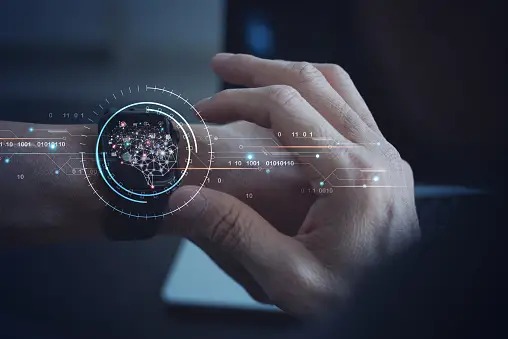Wearables are devices that came into our lives to stay. These small, light, connected products that can be worn on the body like a watch or bracelet.
They have important benefits for the well-being and quality of life of users. So in this article you will learn what wearables are and examples, as well as the advantages and disadvantages.
What is a wearable?
A wearable device is a device or article of clothing that can be worn on the body for monitoring and monitoring purposes. They often contain sensors, processors, communication components and other technologies whose function is to collect data from the user’s body and environment.
This data can be used to provide information or even to control devices and improve the quality of life of their users. Most portable devices use Bluetooth or Wi-Fi connections to sync with smartphones and other compatible devices.
What are the most popular wearables?
The most popular wearables are fitness trackers, smartwatches, and augmented reality (AR) glasses.
- Fitness trackers are bracelets that measure physical activity, such as steps taken, heart rate, calories burned, and more.
- The smartwatch provides hands-free access to notifications, apps and other functions of a smartphone.
- Virtual reality or augmented reality glasses, such as Google Glasses, offer an enhanced visual experience by overlaying digital data on physical objects or environments.
In the textile industry, there are many items of clothing that can measure body temperature and activate heating or ventilation mechanisms for greater user comfort. There are also headphones, sneakers, keychains, among many other accessories.
How does wearable technology work?
Wearable technology is usually based on sensors that collect data from the environment and the user’s body. This data is then processed by an integrated processor or sent to a smartphone, tablet or computer for further analysis.
The data can be used for various purposes, such as monitoring a person’s health or providing information and alerts. Wearables also typically contain actuators that are used to control devices. For example, they can be used to change the volume of a music player or turn on the lights in a room. Wearable technology is becoming more popular and can be used for a variety of useful applications.
It has the potential to revolutionize the way we interact with technology and our environment, allowing us to stay connected, informed and healthy. As technology advances, wearables are likely to become even more sophisticated and integrated into our lives.
It’s an exciting time for this rapidly evolving technology, and it will be interesting to see how wearables are used in the future. Additionally, advances in artificial intelligence (AI) and machine learning (AM) could open up new possibilities for wearables to offer even more personalized and valuable experiences.
Wearable Features
Among the most notable features of wearables are:
- Durability: Wearables must withstand the wear and tear of daily use.
- Energy efficiency: They should last a long time on a single charge and be easy to recharge when necessary.
- Water resistance: Many are designed for use in environments where it is important that they be water resistant.
- Comfort: They should fit the user comfortably and not cause discomfort or irritation when worn for long periods of time.
- Style: They must be attractive and elegant so that people want to wear them.
- The market: They must be affordable so that people can buy them easily.
- Connectivity: It is essential to be able to connect to other devices or networks. This includes Bluetooth and Wi-Fi connections.
- User experience: The user experience of wearables is important to make them attractive. This includes the design, user interface, and features of the device.
- Security: They must be secure to protect data and prevent unauthorized access.
- Platforms: They must be compatible with a number of platforms and devices for users to access their data and functions.
- Analytics: Wearables should provide meaningful analytics that allow users to understand their health, activity, or other metrics.
- Sensors: Many wearables incorporate sensors that can be used to measure physical activity, heart rate or other parameters.
- Application support: Wearables must connect to applications that provide useful information to the user to make decisions or carry out any activity.
What are some applications of wearable technology?
Health and Fitness
- Fitness Trackers: Devices like Fitbit, Garmin, or Apple Watch monitor activity levels, heart rate, sleep patterns, and calories burned.
- Health Monitoring: Wearables can track vital signs like blood pressure, glucose levels, and even detect abnormalities, aiding in early disease detection.
- Personalized Coaching: Wearables offer personalized workout routines and health advice based on collected data, promoting healthier lifestyles.
Medical Industry:
- Remote Patient Monitoring: Wearable devices enable continuous health monitoring for patients, allowing doctors to track their progress remotely.
- Assistive Devices: Wearables aid people with disabilities, such as smart prosthetics or devices assisting the visually impaired with navigation.
Fashion and Lifestyle
- Smart Clothing: Integrating technology into clothing for various purposes, such as temperature regulation, monitoring body movements, or changing colors/patterns.
- Accessories: Fashionable wearables like smart jewelry or smart glasses merge style with functionality, offering notifications and health monitoring discreetly.
Workplace and Productivity
- Employee Productivity: Wearables track employee productivity and wellness, offering insights to improve workflow and well-being.
- Safety and Security: Wearable devices in industries like construction or mining enhance safety by monitoring environmental factors and vital signs.
Entertainment and Gaming
- Virtual Reality (VR) Headsets: Wearable VR devices offer immersive gaming experiences and simulations.
- Gaming Wearables: Devices like gaming gloves or motion sensors enhance gaming interactions and experiences.
Navigation and Location Services:
- GPS Tracking: Wearables provide real-time location data, aiding navigation, especially in outdoor activities like hiking or running.
- Augmented Reality (AR) Glasses: Offer enhanced navigation with overlays of information on the real-world view.
Payment and Transactions
- Contactless Payments: Smartwatches and bracelets equipped with payment technology enable easy, secure transactions without physical cards or cash.
- Authentication: Wearables can serve as authentication devices, replacing traditional methods like keys or cards for access control.
Education and Training
- Interactive Learning: Wearables facilitate interactive learning experiences, such as language translation devices or interactive educational games.
- Skill Development: Devices like smart gloves track movements and provide feedback, aiding in sports training or skill development.
Environmental and Research Applications
- Environmental Monitoring: Wearables collect data on environmental factors like air quality or pollution levels.
- Research Tools: Scientists use wearables to gather data for various studies, from tracking animal behaviors to understanding human interactions.
Advantages and disadvantages of Wearables
Wearable technology can offer a number of benefits, such as greater comfort and safety. For example, by accessing information or controlling devices hands-free, users can stay connected without losing sight of their surroundings.
At the same time, wearables can also provide valuable data that can be used to improve health or safety. However, wearables also come with potential risks, such as privacy or data security issues. Additionally, some users may find them uncomfortable or intrusive. Therefore, it is important to take into account the advantages and disadvantages of wearables before using them.
Future of Wearable Technology
The future of wearable technology is a thrilling landscape of innovation poised to reshape daily life. Evolving beyond mere gadgets, wearables will seamlessly integrate into our routines, offering enhanced connectivity and personalized experiences. From smart fabrics embedded with sensors for health monitoring to AR glasses transforming how we perceive information, wearables will augment human abilities. Miniaturization and advanced materials will drive sleek designs and greater functionality, blurring the line between fashion and tech. Ethical considerations will rise, addressing data privacy and security concerns. As wearables evolve, they’ll revolutionize healthcare, fitness, communication, and beyond, becoming indispensable companions in our tech-infused future.
Conclusion
Wearable technology is becoming increasingly popular and offers users a host of features and benefits. Thanks to their durability, energy efficiency and elegant designs, wearables attract a wide range of customers.
However, it is important to consider the potential risks associated with wearables before using them. Understanding these risks and taking steps to protect data, privacy and security will help ensure that users have a positive experience with their wearable.

